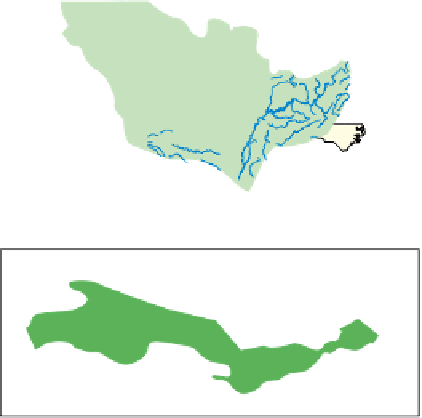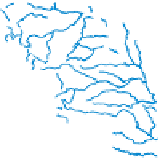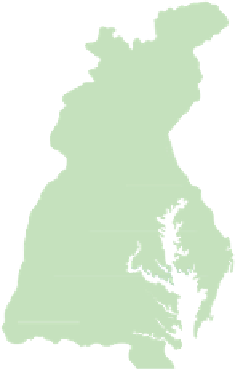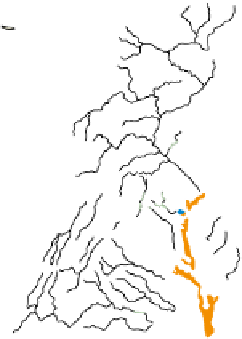Environmental Engineering Reference
In-Depth Information
ment. For example, 85% of the sewage from large cities
along the Mediterranean Sea (with a coastal popula-
tion of 200 million people during tourist season) is dis-
charged into the sea untreated. It causes widespread
beach pollution and shellfish contamination.
Recent studies of some U.S. coastal waters have
found vast colonies of viruses thriving in raw sewage,
effluents from sewage treatment plants (which do not
remove viruses), and leaking septic tanks. According
to one study, one-fourth of the people using coastal
beaches in the United States develop ear infections,
sore throats, eye irritations, respiratory disease, or gas-
trointestinal disease.
Runoffs of sewage and agricultural wastes into
coastal waters introduce large quantities of nitrate and
phosphate plant nutrients, which can cause explosive
growth of harmful algae. These
harmful algal blooms
(HABs) are called red, brown, or green toxic tides, de-
pending on their color. They can release waterborne
and airborne toxins that damage fisheries, kill some
fish-eating birds, reduce tourism, and poison seafood.
According to the U.N. Environment Programme,
each year some 150 large
oxygen-depleted zones
(some-
times inaccurately called dead zones) form in the
world's coastal waters and in landlocked seas such as
the Baltic and Black Seas. These zones result from ex-
cessive nonpoint inputs of fertilizers and animal
wastes from land runoff and deposition of nitrogen
compounds from the atmosphere.
This cultural eutrophication depletes dissolved
oxygen. Without oxygen, most of the aquatic life (ex-
cept bacteria) dies or moves elsewhere. The biggest
such zone in U.S. waters and the third largest in the
world forms every summer in a narrow stretch of the
Gulf of Mexico off the mouth of the Mississippi River
(Figure 11-29).
Preventive measures for reducing the number and
size of these oxygen-depleted zones include reducing
nitrogen inputs from various sources, planting forests
and grasslands to soak up excess nitrogen and keep it
out of waterways, improving sewage treatment to re-
duce discharges of nitrates into waterways, further
reducing emissions of nitrogen oxides from motor ve-
hicles, and phasing in forms of renewable energy to re-
place the burning of fossil fuels.
Mississippi
River Basin
Ohio
River
Ohio
River
Missouri
River
Missouri
River
Mississippi
River
Mississippi
River
LOUISIANA
Mississippi
River
Depleted oxygen
Gulf of Mexico
Figure 11-29
Natural capital degradation:
a large zone of
oxygen-depleted water (less than 2 ppm dissolved oxygen)
forms for half of the year in the Gulf of Mexico as a result of
oxygen-depleting algal blooms. It is created mostly by huge
inputs of nitrate (NO
3
) and phosphate (PO
3
) plant nutrients
from the massive Mississippi River basin. In 2002, this area
(shown in green) was roughly equivalent to the area of
the U.S. state of New Jersey or the Central American country
of Belize.
from 3.7 million to 17 million, and it may soon reach
18 million.
The estuary receives wastes from point and non-
point sources scattered throughout a huge drainage
basin that includes 9 large rivers and 141 smaller
streams and creeks in parts of six states (Figure 11-30).
Cooperstown
NEW YORK
PENNSYLVANIA
ATLANTIC
OCEAN
Harrisburg
NEW
JERSEY
MARYLA
N
D
Baltimore
Washington
WEST
VIRGINIA
DELAWARE
p
Science Case Study: The Chesapeake Bay
Pollutants from six states contaminate the shallow
Chesapeake Bay estuary, but cooperative efforts have
reduced some of the pollution inputs.
Since 1960, the Chesapeake Bay—the United States'
largest estuary—has been in serious trouble from
water pollution, mostly because of human activities.
One problem is that between 1940 and 2004, the num-
ber of people living in the Chesapeake Bay area grew
Richmond
J
VIRGINIA
C
hesapeak
e
Bay
Norfolk
Drainage
basin
No oxygen
Low concentrations
of oxygen
Figure 11-30
Natural capital degradation:
Chesapeake Bay,
the largest estuary in the United States, is severely degraded as
a result of water pollution from point and nonpoint sources in six
states and from deposition of air pollutants.























































